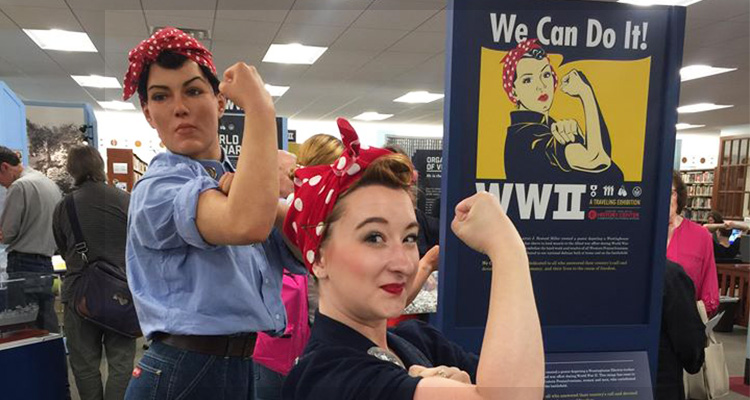Each year we lose nearly 400 veterans from World War II. According to the U.S. Department of Veterans Affairs statistics, only 558,000 of the 16 million Americans who served in World War II were alive in 2017. Referred to by celebrated journalist Tom Brokaw as The Greatest Generation, this revered group of Americans is fading into the past. In fact, WWII itself is slowly becoming distant history, especially for today’s youth, who learn less about the war than generations prior.
To slow this progression, the Heinz History Center in Pittsburgh created “We Can Do It! WWII,” a traveling exhibit about the war focusing on the home front, veterans and industry. It opened to the public at the Ohio County Public Library in Wheeling on Saturday, May 26, with a grand ceremony. The exhibit will remain at the OCPL until July 24 when it moves on to California University of Pennsylvania.
“We Can Do It! WWII” Exhibit
“We Can Do It! WWII” was developed by the Heinz History Center as a means of recognizing regional contributions to the war. The “We Can Do It! WWII” traveling exhibition will visit a total of 18 cultural institutions throughout Western Pennsylvania by the time it ends its journey on April 7, 2020, at the Donora Historical Society and Smog Museum in Donora, Pa. The OCPL is the only location in West Virginia where the exhibit will be featured. It is provided free of charge to members of the History Center Affiliates Program, a collection of more than 125 historical organizations throughout the tri-state area.
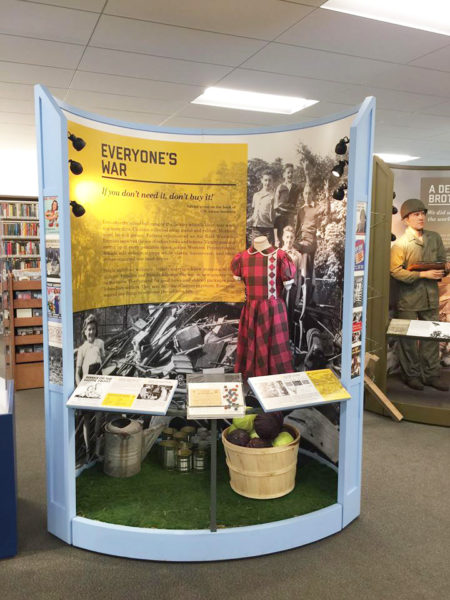
Visitors to the exhibit will learn about the development of the Jeep, a uniquely American invention produced by the American Bantam Car Company in Butler, Pa., and hear the stories behind Rosie the Riveter and the local Tuskegee Airmen whose contributions helped to turn the tide of the war.
The exhibit showcases four lifelike museum figures of WWII heroes: General George C. Marshall, Tuskegee Airman Lt. Carl J. Woods, Iwo Jima hero Sgt. Michael Strank and the Westinghouse Company-inspired Rosie the Riveter.
The OCPL has added Wheeling artifacts and events to the exhibit to give it a unique local focus. OCPL archivist Laura Carroll said that “the local components really bring it home.” Some of the objects are on loan from Wheeling organizations and residents. Other artifacts are from the Ohio County Public Archives, which holds a robust collection of historic Wheeling materials. Some of these local items include the following: a U.S. Cadet Nurse Uniform worn by a nurse who served at Wheeling Hospital from 1944 to 1945; postcards and Air Force Silver Wings from Wheeling-born Freddie Elkes, who died as a prisoner of war; and photographs and telegrams to and from Wheeling-born John E. Vest, who was a German prisoner of war.
Wheeling resident Susan Haddad loaned some Wheeling Corrugating items and her father’s belongings to the exhibit. The late Dr. Howard Brettell of Steubenville served as a Front Line Surgeon with the 3rd Auxiliary Surgical Group in the African, Sicilian and European campaigns and commanded General Surgical Team No. 2, landing on Utah Beach during the D-Day invasion. While in England, he served with the British intelligence. In addition, he was a recipient of the Bronze Star. You can see his coat and other items on display near the Wheeling Room.
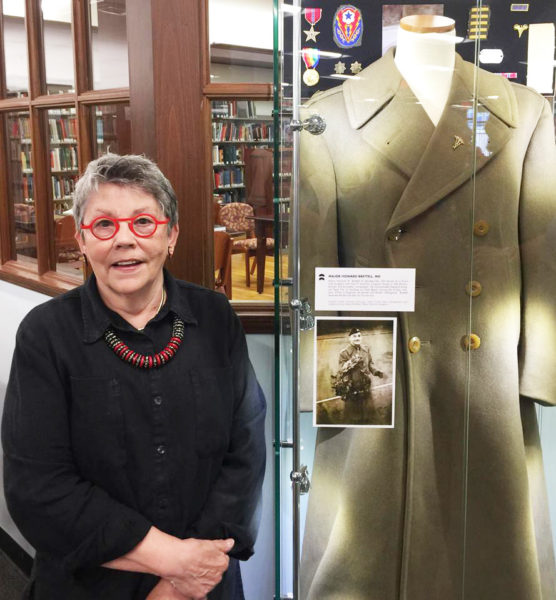
Opening Day
The exhibit opened Memorial Day weekend with a bittersweet program honoring both the proud accomplishments of Americans during the war and their incredible sacrifices. Erin Rothenbuehler, OCPL head of programming, publicity and archives at the library, opened the program with an introduction to the exhibit and upcoming coordinating events. Alyssa Bruno, dressed as Rosie the Riveter, sang the National Anthem.
Wheeling Mayor Glenn Elliott Jr. talked about West Virginia’s role in WWII by noting that more than 5,000 West Virginians were killed during the war. In addition to those sacrifices, Wheeling, along with Pittsburgh, became the “arsenal of democracy” by putting its factories and workers, including thousands of women, into service producing weapons and other wartime tools. Mayor Elliott reminded the packed audience that “we study history to learn.” He also urged those in attendance to “look at this exhibit as a way to remember that we once worked together.” He noted that it “seems almost foreign now that were once united like we were then.”
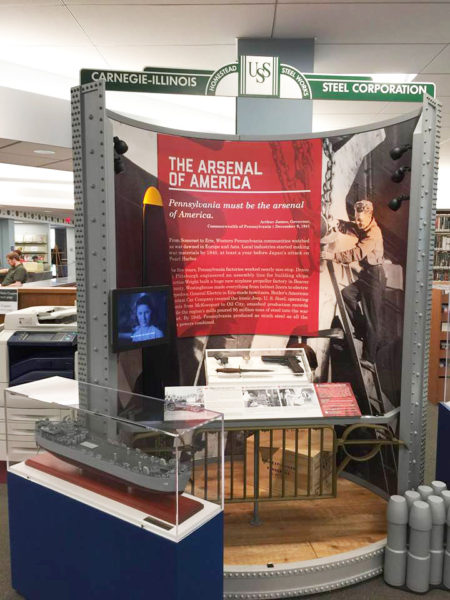
Following the mayor’s remarks, Robert Stakeley, manager of the Heinz History Center Affiliates Program, referenced to the WWII exhibit as part of the Heinz’s “ongoing partnership with Wheeling.” Specifically, he noted that affiliate sites, like the OCPL, are “on the front lines of collecting, protecting and accessing history.” Stakely said he was impressed with the way in which the OCPL incorporated local artifacts and is coordinating programs with the exhibit, and the Heinz History Center plans on using the OCPL as the model site for the exhibit as it travels onward. In addition, he reminded the crowd that “everyone starts out ordinary. Ordinary people come together and do extraordinary things.” In his closing remarks, Stakeley called on the audience to continue telling the history of WWII, imploring that “you have the responsibility to keep these stories alive.”
Local bagpiper, Betsy Bethel McFarland, played taps and “Amazing Grace” as the Post 1 American Legion Color Guard presented the American and West Virginia state flags. Father James Conroy, S.J. and Rabbi Joshua Lief offered an interfaith memorial prayer.
Following the program in the library’s auditorium, attendees moved upstairs to the second floor for a ribbon cutting and guided tours of the exhibit. Visitors can tour the exhibit free of charge during the library’s regular hours. The exhibit will be housed at the OCPL until July 24 when it moves on to California University of Pennsylvania.
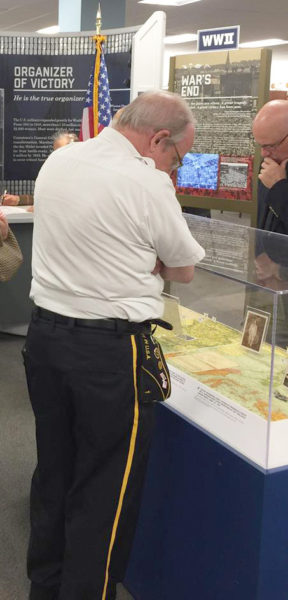
Continuing the Conversation
In addition to the exhibit, the OCPL has planned multiple events around WWII. The People’s University, which opened last week, continues through July 24. Classes are held every Tuesday night at 7 p.m.
Also, three Lunch With Books programs will focus on WWII throughout the exhibit’s run, including a program devoted solely to memories of Wheeling in WWII at noon Tuesday, June 5. The “Ladies of Liberty” session will feature patriotic WWII-era songs in the style of the Andrews Sister at noon July 3.
Other special programs include a Flag Day Celebration on June 14, a film screening of “The Life and Times of Rosie the Riveter” on June 25, and a presentation by Cantor Wisnia, a Holocaust survivor, on July 12.
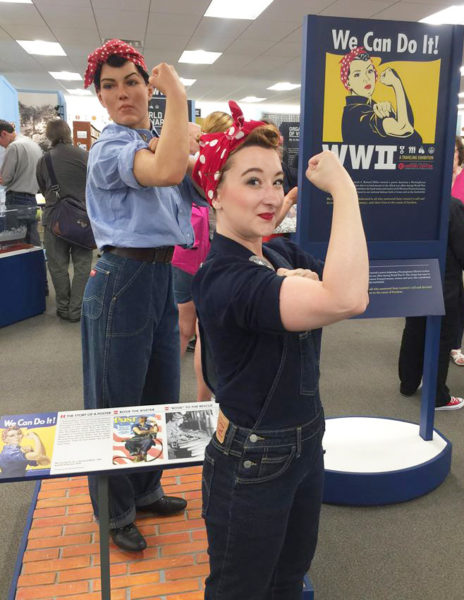
The OCPL is encouraging the public to get involved with four special online programs. Don your best Rosie the Riveter costume and send your picture to the library or post it on social media. Tag the library in your post, and you could win a Rosie action figure and a one-year family membership to the Heinz History Center.
The OCPL is asking for the public’s help in identifying WWII-era soldiers and sailors from their online collections. Also, the library is looking for photos and stories of Ohio Valley friends and family who served in the military or on the home front during the war to include in their Ohio Valley WWII Family Photo Album. Lastly, watch for special stories related to the local exhibit items and other collections not on display at archivingwheeling.org.
For many Americans living today, WWII is an abstraction, but for the surviving members of The Greatest Generation, it was once their reality. An exhibit such as “We Can Do It! WWII” reminds visitors of a time in history in which Americans worked together to fight for the greater good, and as one veteran remarked standing before the exhibit, “Being here today reminded a bunch of old people what it was like to be young again.”
(Photos by Christina Fisanick)


